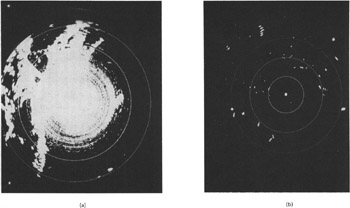Radar Handbook, Second Edition

William W. Shrader
V. Gregers-Hansen
Equipment Division
Raytheon Company
The purpose of moving-target indication (MTI) radar is to reject signals from fixed or slow-moving unwanted targets, such as buildings, hills, trees, sea, and rain, and retain for detection or display signals from moving targets such as aircraft. Figure 15.1 shows a pair of photographs of a PPI (plan position indicator) which illustrate the effectiveness of a properly working MTI system. The distance from the center to the edge of the PPI is 40 nmi. The range marks are at 10-nmi intervals. The picture on the left is the normal video display, showing the fixed-target returns. The picture on the right shows the MTI clutter rejection. The camera shutter was left open for three scans of the antenna; thus aircraft show up as a succession of three returns.

MTI radar utilizes the doppler shift imparted on the reflected signal by a moving target to distinguish moving targets from fixed targets. In a pulse radar system this doppler shift appears as a change of phase of received signals between consecutive radar pulses. Consider a radar which transmits a pulse of RF energy that is reflected by...
